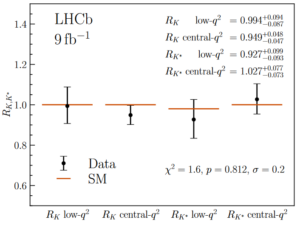A new analysis of measurements with the LHCb detector at CERN on rare B decays shows similar behaviour between muons and electrons. This is expected in the standard model, but still very puzzling, LHCb physicists say.
The new results were announced Tuesday morning at a seminar at CERN in Geneva on so-called lepton universality. Two articles on the new results for parameters called Rk and Rk* were published simultaneously online on the web storage site Arxiv.
Rare decays
LHCb reported earlier evidence that in the decay of the charged B-meson to a charged kaon and two leptons, fewer muons occurred than theory predicts. However, this comparison suffers from large theoretical uncertainties. Nikhef is a partner in the LHCb collaboration in Geneva.

LHCb has been making measurements of such differences via decay processes of B-mesons via kaons in which, in theory, two electrons can be released as often as two muons. B-mesons are frequently produced in proton collisions at the LHC accelerator at CERN.
Excitement
Earlier, there seemed to be evidence that in the decay of the charged B-meson to a charged kaon and two leptons, fewer muons than electrons occurred. These results lead to what researchers themselves called “cautious excitement” in the media last year. A serious difference between muons and electrons could signal unknown processes. This would require a modification or extension of the standard model.
In the new publications, LHCb’s measurements of B-meson decay are even more precise, in some cases with three times more data than previously available. At the same time, some uncertainties have increased somewhat, as signals from electrons are more difficult to analyze.
Puzzle
In the new LHCb analysis, the difference between measurements with electrons and with muons appears to disappear. However, this happens not because the muons conform better to the prediction of the standard model, but because now the electrons also seem to show a similar deviation. “The puzzle just deepens”, said LHCb program leader Marcel Merk at Nikhef.
LHCb physicist Patrick Koppenburg, also at Nikhef: “If the measurements of the muons had moved up to the standard model value, this would have been the end of our cautious excitement. Then there would be no anomaly. But now we see that the electrons also deviate from the standard value and that’s a new mystery.”

